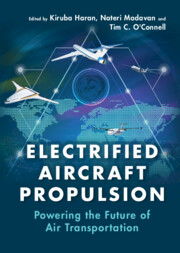Book contents
- Electrified Aircraft Propulsion
- Electrified Aircraft Propulsion
- Copyright page
- Dedication
- Contents
- Contributors
- Preface
- 1 Benefits of Electrified Propulsion for Large Aircraft
- 2 Aircraft Electric Power System Design, Control, and Protection
- 3 Megawatt-Scale Electric Machines for Electrified Aircraft Propulsion
- 4 Superconducting Machines and Cables
- 5 Conventional Power Electronics for Electrified Aircraft Propulsion
- 6 Cryogenic Power Electronics
- 7 Electrochemical Energy Storage and Conversion for Electrified Aircraft
- 8 Thermal Management of Electrified Propulsion Systems
- 9 Performance Assessment of Electrified Aircraft
- Index
- References
3 - Megawatt-Scale Electric Machines for Electrified Aircraft Propulsion
Published online by Cambridge University Press: 11 May 2022
- Electrified Aircraft Propulsion
- Electrified Aircraft Propulsion
- Copyright page
- Dedication
- Contents
- Contributors
- Preface
- 1 Benefits of Electrified Propulsion for Large Aircraft
- 2 Aircraft Electric Power System Design, Control, and Protection
- 3 Megawatt-Scale Electric Machines for Electrified Aircraft Propulsion
- 4 Superconducting Machines and Cables
- 5 Conventional Power Electronics for Electrified Aircraft Propulsion
- 6 Cryogenic Power Electronics
- 7 Electrochemical Energy Storage and Conversion for Electrified Aircraft
- 8 Thermal Management of Electrified Propulsion Systems
- 9 Performance Assessment of Electrified Aircraft
- Index
- References
Summary
This chapter identifies the specifications of megawatt (MW)-scale electric machines (EMs) that facilitate electrified aircraft propulsion (EAP). Because their specific power (SP) must increase by an order of magnitude over the current state-of-the-art (SOTA), a review of conventional EMs for EAP is presented, focusing on approaches for mass reduction and SP increase. Design challenges associated with high specific power (HSP) MW-scale machines are identified, and a review of EAP powertrain architectures and how HSP EMs enable them is provided. Next follows a description focused on propulsion motors, high speed generators, and system considerations unique to the EAP powertrain. Design principles for high power, lightweight, MW-scale EM development are discussed, and a comprehensive survey of over 50 SOTA HSP machines is presented. Common HSP machine features are identified and promising options for further weight reduction are discussed. Despite their SOTA classification, the surveyed machines fall well short of the lofty requirements necessary for next generation components, and some emerging technologies that may help to remedy these shortcomings are described.
Keywords
- Type
- Chapter
- Information
- Electrified Aircraft PropulsionPowering the Future of Air Transportation, pp. 49 - 87Publisher: Cambridge University PressPrint publication year: 2022

